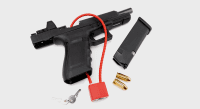Successful implementation of a five-character override in automatic dispensing cabinets
- Automated dispensing cabinets offer many benefits, including reduced frequency of certain medication errors (such as look-alike/sound-alike errors) but their use isn’t without risk.
- Override functionality for emergent medication administration situations bypasses many safety nets, including pharmacist review and verification of medication orders.
- Programming additional security functionality, such as five-character override requirement, can mitigate risk and improve patient safety.
According to Tariq and colleagues, 7,000 to 9,000 people die annually in the United States secondary to a medication error; cost of these errors exceeds $40 billion a year. The American Society of Health System Pharmacists defines a medication error as any preventable event that may cause inappropriate medication use or patient harm while the healthcare professional controls the medication. In addition to harm, these errors lead to decreased patient satisfaction and a lack of trust in the healthcare system. Improving healthcare outcomes requires mitigation of medication error risk.
To address this need for mitigation, a pediatric health system successfully implemented the Institute for Safe Medication Practices (ISMP) recommendation for a five-character override when removing medication from an automated dispensing cabinet (ADC).
The nurse’s role in medication safety
Medication errors: Best Practices
Understanding the problem
ADCs, which store, track, and dispense medications within a healthcare setting, help reduce the frequency of certain medication errors, such as look-alike/sound-alike. However, they’re not without risk.
According to ISMP, profiling functionality offers the safest option for removing medications from an ADC because it requires computerized provider order entry (CPOE) and pharmacist review and verification. Override functionality, an alternative to profiling functionality, exists for emergent situations. Users can bypass CPOE and pharmacist review and verification if medication administration delays could cause patient harm.
Although removing medication via the override function circumvents many safety nets, clinicians view this process as routine rather than risky. Programming additional ADC security functionality will minimize risk. In January 2019, ISMP recommended using at least five characters of a drug name when removing medications via the override function. This recommended practice reduces look-alike/sound-alike mistakes, confirmation bias, and other errors.
When nurses lack familiarity with a medication name or encounter distractions, they can inadvertently select the wrong medication from those listed on the screen during drug name searches. Every nurse learns the five rights of medication administration (right patient, right drug, right dose, right time, and right route in their academic preparation), but medication errors still occur. In March 2022, nurse RaDonda Vaught was found guilty of negligent homicide and felony abuse of an impaired adult. She had inadvertently removed vecuronium instead of Versed from an ADC when using the override function, resulting in a fatal medication error. This case garnered national attention and highlighted the importance of medication safety and the impact on patients.
Those who understand the connection between technology and nursing practice can see how this could happen to any one of us. These circumstances identified the need for system improvements and additional safeguards when using an ADC. ISMP stated that progress must be made in systems designed to achieve the five rights of medication administration, and organizations must create failsafe methods to achieve them.
Working toward a solution
With interprofessional collaboration, thorough testing of ADC cabinet workflows, and focus groups held with bedside nursing staff, our large tertiary pediatric hospital system in the Dallas-Fort Worth Metroplex successfully transitioned its ADC override search function from one character to five. Strong nursing and pharmacy teamwork proved essential when implementing this practice change. Team members included the pharmacy director, vice president of nursing excellence, the nursing practice program manager, an advanced clinical nurse, an ADC pharmacy technician, a clinical pharmacist, a clinical nursing educator, and a senior communications executive.
Potential challenges to this solution include misspelling a drug name or difficulty locating drugs known by several different names, which could lead to failure in finding an emergency drug and delays in patient care. Existing literature lacks strategies to adopt this best practice while reducing the risk of delays in medication administration.
Benchmarking
We began by collaborating with other pediatric organizations implementing any version of this practice change. Feedback received from two facilities provided insight into the five-character requirement. One organization had made the change several years before and experienced some nurse frustration and adjustments. However, after the media focus on the RaDonda Vaught case, their nurses expressed gratitude and support because they now understood the positive impact on medication error reduction. A few pediatric organizations had implemented a three-character search requirement but were reluctant to move toward the full five characters. They spoke of risks to the nursing workflow and resulting delays in patient care. However, these organizations expressed an intention to explore the five-character functionality in the future.
Nurse focus groups
We held virtual focus groups within the organization’s established shared governance structure with bedside nurse volunteers from the five core councils. Common themes related to increased patient safety and enhanced protection for nurses emerged. Some nurses expressed concern about potential delays in patient care and the significant impact on nursing workflow. Nurses shared that they frequently use override functionality during patient admissions or emergent situations to reduce delays and anticipate patient needs. Nurses felt that adequate preparation, education, and resources would help reduce care delays and any impact on workflow. (See Nurse perceptions.)
Nurse perceptions
As part of the preparations for implementing five-character override in our hospital system’s automated dispensing cabinet technology, the project team held focus groups with nurses from throughout the organization. In those groups, nurses discussed their perceptions of the impact of this requirement.
ADC user validation testing
To understand how practice changes would impact different units, departments, and clinicians, the project team identified areas where ADC override frequently occurs. The findings suggested that the postanesthesia recovery unit, emergency department, and special procedures unit had the highest number of ADC overrides. These areas also use non-profiled ADCs, which don’t always have 24-hour pharmacy support. Removing medications from a non-profiled ADC looks like an override, but the ADC cabinet won’t reflect active orders or pharmacy verification without profiling functionality.
Optimizing the use of ADCs with profiling functionality is one of ISMP’s safe practice recommendations; however, effective patient care requires the use of non-profiled ADCs in certain areas. Our team wanted to ensure that the change from one to five characters wouldn’t significantly delay or affect nursing workflow, negatively impact patient care, or jeopardize patient safety, especially in areas that rely on non-profiled ADCs.
The team tested the five-character requirement on two campuses across various departments and patient specialties. Bedside nurses agreed to perform ADC testing using simulated medication withdrawal with cabinet override functionality while the project team collected data using a survey in Microsoft Forms. We activated the five-character requirement on a select ADC in each area for a short period. Nurses had access to an alphabetized list of all generic medication names available in the ADC. We simulated medication withdrawal scenarios with nurses working in those areas, measured the time to complete medication procurement, and verified whether they used the spelling resource. Although we didn’t conduct the simulation on actual patient medication, we did conduct it in patient care areas with nurses on shift. User testing/validation allowed us to understand the bedside clinician’s experience with the five-character requirement and evaluate the practice change’s usability.
On average, it took nurses 11 seconds to complete an override using five characters. Although nurses had access to a spelling resource, 65% completed the five-character override without assistance. Nurses who needed spelling help opted to ask a coworker rather than use the provided resource, as they perceived the coworker would have a readily available answer. This course of action creates a cause for concern due to possible delays if coworkers can’t accurately spell the medication name. The project team opted to include a generic medication name spelling list as a process change resource for nurses.
Resources, education, communication
The nurse volunteers provided overwhelmingly positive feedback of the five-character override, but they anticipated a learning curve and growing pains. When asked what resources might prove helpful, nurses requested the addition of common and well-known synonyms to the ADC library. Pharmacists and nurses created and approved a short list of synonyms, allowing nurses to search the first five characters of these synonyms when removing the medication as a cabinet override. Nurses also requested the inclusion of a synonym list and a spelling list of all drugs as a QR code posted on all ADC cabinets. In anticipation of synonym changes and the addition of new medications, the project team selected QR code technology that allows for continuous resource updates.
The team’s clinical nursing educator, program manager of nursing excellence, and advanced clinical nurse collaborated to create education for nurses, pharmacists, and respiratory therapists. With the help of a videographer, they developed a computer-based training (CBT) exercise demonstrating the new workflow. The CBT outlines the process change, shares helpful information about appropriate use of ADC cabinet overrides, and demonstrates QR code use to access resources. All clinicians licensed and privileged to administer medications had to view the CBT 1 week before the go-live date.
With guidance from the senior communications executive member, the team developed a robust communication plan using several avenues. We published an article in the Balloon Beat, a thrice-weekly email communication to all staff. In addition, we used the nursing and clinical leadership team newsletters to spread the word. Anesthesiologists and medical providers received formal communications via email.
We also announced the process change at the daily safety briefing during the week before implementation, ensuring all leaders and executives attending the call knew about the upcoming process change. Microsoft Viva Engage (a tool for sharing knowledge and starting conversations) and SnapComms (internal communication software) helped ensure everyone received reminders of the upcoming change in real time on the go-live day.
Challenges and limitations
QR code resources offer a great option for providing up-to-date information to nurses, but they’re not without technical difficulties. Our organization uses QR code technology to make resources available to staff and allow for updates, which avoids the pitfalls of outdated print materials. Initially, we used a QR code reader application banned during the Russian sanctions instituted in 2022. Finding and testing a suitable replacement proved a lengthy process. Replacing the QR code reader application wasn’t a component of this project, but it did cause significant delays.
After analyzing the environment and rapid workflows in the operating room and automated anesthesia carts, the project team omitted them from the five-character requirement. Although similar to an ADC, automated anesthesia carts store only medications administered during anesthesia. The cart contains an intelligent computer system and automatically records medication information during anesthesia. Given the isolated environment, the limited selection of drugs, and restricted access to only anesthesiologists, anesthesiologist assistants, and certified RN anesthetists, the team determined that anesthesia carts could opt out of the practice change.
Ensuring all clinicians in all areas receive adequate communication and training can prove challenging with any process change. For example, our practice change communication and education reached only some ambulatory areas. A better understanding of internal processes within clinical education departments can help ensure accurate deployment of training and resources to those who need them.
Nursing implications
Implementation of the five-digit override requires that nurses know the correct spelling of generic medication names; previously they had to know oly the first letter. Nurses also must be aware of the resources they can turn to if they don’t know the correct spelling.
Significant collaboration
To reduce medication errors, healthcare organizations must align their ADC use with current evidence-based practice recommendations. Bedside nurses frequently go overlooked when implementing a practice change, but their knowledge and expertise can prove critical in planning and designing systems aimed at improving patient safety. Interprofessional collaboration played a significant role in the implementation of our healthcare system’s risk reduction strategies related to ADC medication dispensing practices across all patient care areas.
Melissa Ruffini is an advanced clinical nurse at Children’s Health in Dallas, Texas. Christina Sanchez is a gastroenterology, hepatology, and clinical nutrition pediatric nurse practitioner at UT Southwestern Medical Center in Dallas.
References
Billstein-Leber M, Carrillo CJD, Cassano AT, Moline K, Robertson JJ. ASHP guidelines on preventing medication errors in hospitals. Am J Health-Syst Pharm. 2018;75(19):1493-1517. doi:10.2146/ajhp170811
Grissinger M. The five rights: A destination without a map. P.T. 2010;35(10):542.
Grissinger M. Safeguards for using and designing automated dispensing cabinets. P.T. 2012;37(9):490-530.
Harrington L. The RaDonda Vaught case: A critical conversation on nursing practice and technology. AACN Adv Crit Care. 2023;34(1):11-5. doi:10.4037aacnacc2023873
Institute for Safe Medication Practices. Challenges with requiring five characters during ADC drug searches via override. October 21, 2021. ismp.org/resources/challenges-requiring-five-characters-during-adc-drug-searches-override
Institute for Safe Medication Practices. Over-the-top risky: Overuse of ADC overrides, removal of drugs without an order, and use of non-profiled cabinets. October 24, 2019. ismp.org/resources/over-top-risky-overuse-adc-overrides-removal-drugs-without-order-and-use-non-profiled
Mandrack M, Cohen MR, Featherling J, et al. Nursing best practices using automated dispensing cabinets: Nurses’ key role in improving medication safety. Medsurg Nurs. 2012;21(3):134-44.
Rhodes JAM, Bondi DS, Celmins L, Hope C, Knoebel RW. Quality improvement and reconciliation process for automated dispensing cabinet medication overrides. Am J Health Syst Pharm. 2022;79(4):306-13. doi:10.1093/ajhp/zxab406
Tariq RA, Vashisht R, Sinha A, Scherbak Y. Medication dispensing errors and prevention. StatPearls. May 2, 2023. pubmed.ncbi.nlm.nih.gov/30085607
Think Design Collaborative. User testing/validation. bit.ly/3UllFFg
Traynor K. Joint Commission eyes overrides of dispensing cabinets. Am J Health Syst Pharm. 2018;75(9):e172-3. doi:10.2146/news180026
Wang Y, Du Y, Zhao Y, Ren Y, Zhang W. Automated anesthesia carts reduce drug recording errors in medication administrations—A single center study in the largest tertiary referral hospital in China. J Clin Anesth. 2017:11-5. doi:10.1016/j.jclinane.2017.03.051
Key words: medication safety, automated dispensing cabinet, medication error, override



















